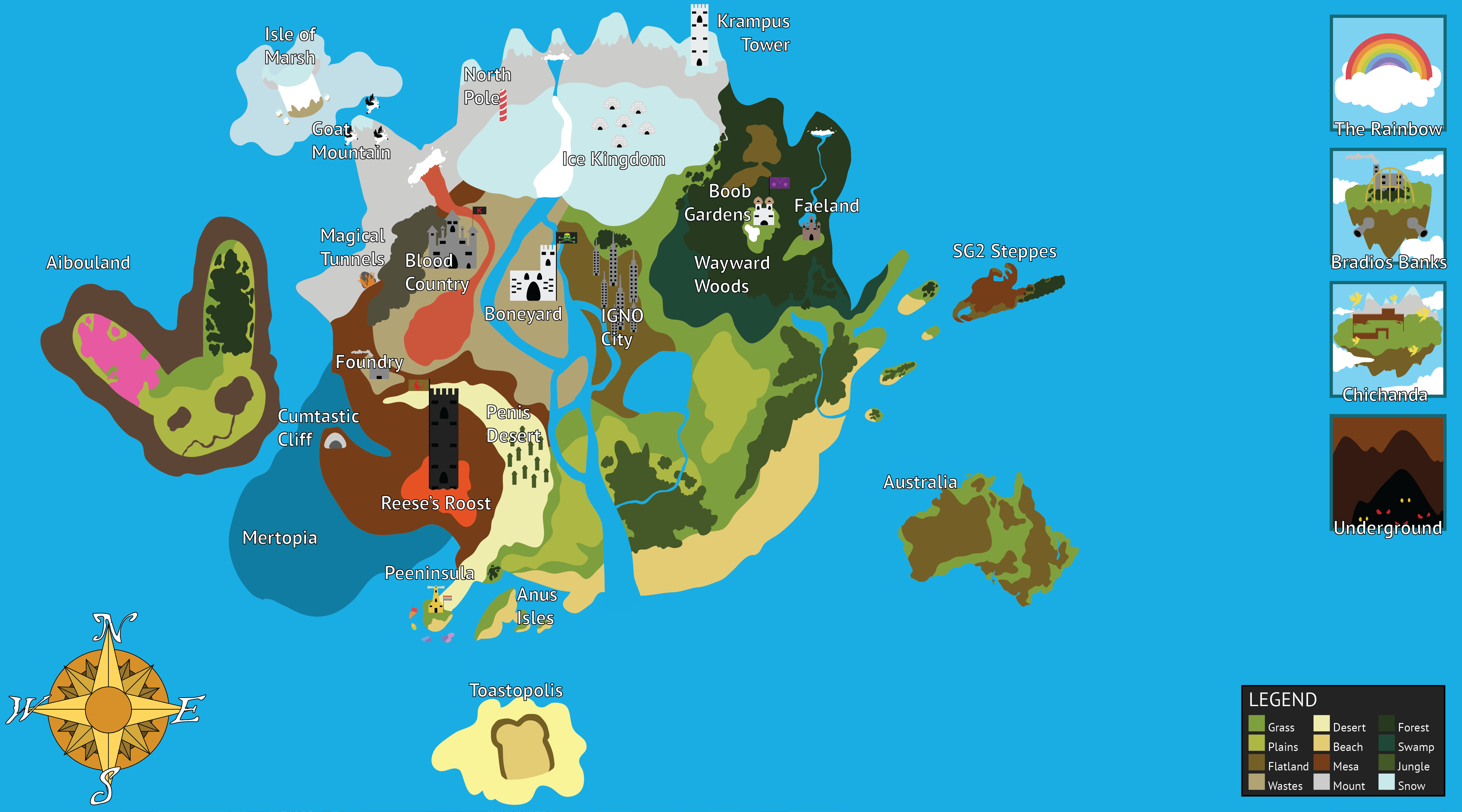This directory contains a listing of all the significant places in IGNOLand.
Sn interactive map is currently in the works. In the meantime please use the static map below as a guide and select the place you wish to learn about from the sidebar. Below the map is a listing of some useful information for understanding the map and nation pages.
Biome Types
The general composition of the land.
Grassland: Very grassy. Scattered trees, probably some hills.
Plains: Similar to grasslands, but with shorter grass, and very few trees and hills.
Flatland: Very flat. Almost no hills or valleys. Likely surrounded by another biome type.
Wastes: Dead land upon which little can grow. Many a tumbleweed.
Desert: Dry, hot, full of sand. Cacti everywhere, and the occasional bushes and shrubs. If you're lucky, you'll happen upon an oasis.
Beach: Sunny and tropical coastal region. Excellent fishing area. Can be sandy or rocky.
Mesa: Dry cliffs and small mountains. Likely to find caves. Few trees. Typically warm.
Mountains: High peaks and dangerous cliffs. Maybe caves. High elevation, typically cold.
Cavernous: Cave interiors, usually in mountainous regions. Temperature depends on climate. Usually dark. Probably bats. Likely to lead deeper underground.
Forests: Dense wooded areas surrounded by trees and abundant in flora and fauna alike. Likely to find rivers and lakes nearby.
Swampland: Damp and warm. Less trees than a forest, but still very green. Breeding ground for fungi. Lots of marshes.
Jungle: Tropical forests. Likely to find exotic fruits and dangerous wildlife.
Polar: Extremely cold. Snow and ice. Probably mountains.
Volcanic: Extremely hot. Volcanoes are probably active. Watch out for lava.
Aquatic: Under the sea.
Urban: A heavily-modernized area within any of the above biomes. Trees are usually sparse, land paved over, with lots of buildings and other man-made structures.
Measurement Scales
To keep things simple, a few of the sections on the nation pages are measured by scales rather than raw numbers. For instance, rather than give a concrete estimate of a nation's population (difficult), we would measure it as 'high' or 'low' (simple) relative to IGNOLand as a whole. Here are the scales to be aware of.
Nation Size
Tiny: A very small area. If populated at all, the population is miniscule, with at most two villages or tribes. May be a privately-owned location.
Small: A small nation or island, typically with low to medium population. May have anywhere from 2 to 5 individual villages or towns, or one city.
Average: A decent sized nation or island, usually with a medium population. May have between 4 and 7 villages/towns/communities, typically with at least one decent-sized city.
Large: A nation that covers a large area, or an island up to the size of two Average nations. Typically has at least 10 individual communities, usually with a well-known city or central hub. The population often ranges from medium to high.
Enormous: A nation or landmass that could occupy multiple average nations. An enormous-rank island constitutes as a continent in its own right. The population can range from medium to massive, depending on the area.
Population
Miniscule: Barely inhabited at all, with an estimated less than 100 people.
Low: Small population, usually between 200-700 people.
Medium: Average population, anywhere from 1,000 to 2,000 people.
High: Large population ranging from 3,000 to 8,000 people.
Massive: Very large population - may verge on overcrowded depending on the area. Generally reaches from 10,000 to 30,000 people.
Power Estimate
A general measure of where the nation stands in the scope of the world as a whole, in terms of influence or military might.
Insignificant: This nation is of little value to those other than its own citizens - many have not even heard of it. Does not tend to have terribly desirable exports, has a weak or nonexistent national defense, and is not likely to be a tourist destination. Very likely to be conquered.
Irrelevant: People are aware this nation exists, they just don't care. Likely has some trade relations with other neighboring countries and will attempt to defend itself if attacked. Not a popular tourist destination. Likely to be conquered.
Reasonable: An average nation with an established presence in the world, though often overshadowed by larger nations. Has a competent national defense and useful exports. Occasional tourist destination. May be conquered by larger nations, but has a fair shot of driving off attackers.
Significant: Everyone knows about this nation. Many wish to visit or live here one day, and few dare to attack it. The exports it provides are valuable, and it is smarter to form alliances with it than make it an enemy. A popular tourist destination. Unlikely to be conquered.
Overwhelming: This nation's power is through the roof, and is ever-growing. Typically has a booming population and high levels of tourist activity. Has very valuable exports and many trade partners, making it a great trade partner. With extremely powerful national defense, few would dare to attack it. World domination imminent.
Allegiance
The general stance of a nation with the major world power (at this time, Konungur Bones).
Hostile: Against the major power, and likely to launch attacks.
Against: Against the major power, but unlikely to attack. Favors protests and smear campaigns.
Neutral: With enemies, you know where they stand. But with Neutrals? Who knows. It's sickening. Tend to have no strong feelings one way or the other.
Allied: Formally allied with the major power, usually through fear or convenience more than support.
Supportive: Allied with the major power out of support for its governmental practices. Likely to come to this nation's aid in times of strife.






